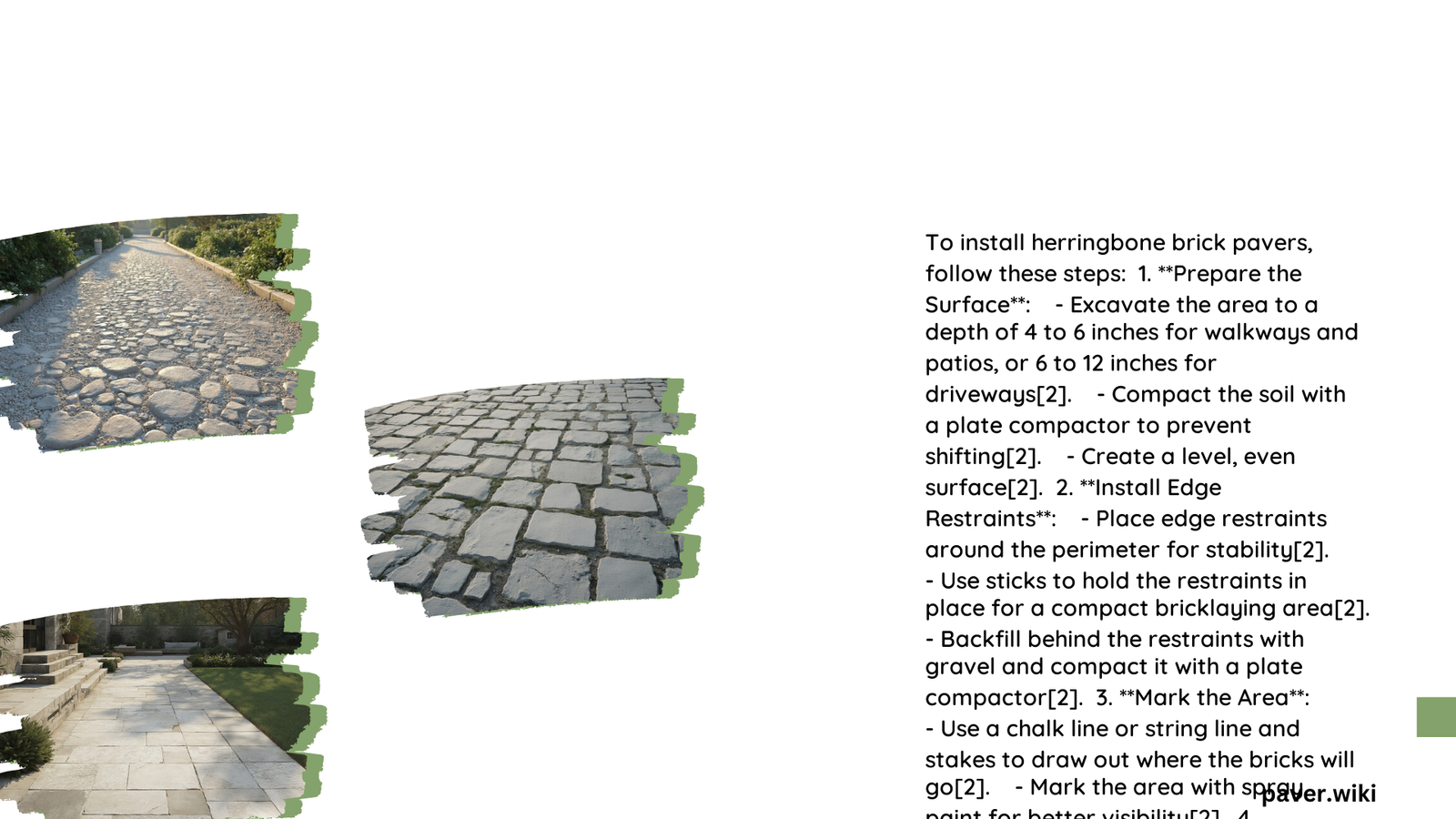Installing herringbone brick pavers is a popular choice for creating visually appealing and durable outdoor surfaces. This intricate pattern requires careful planning and execution. The process involves preparing the area, laying a proper foundation, precisely placing the pavers in a 45-degree angle pattern, and finishing with appropriate edging and filling. This guide provides detailed steps and tips for successfully installing herringbone brick pavers.
What Tools and Materials Are Needed for Installing Herringbone Brick Pavers?
Before starting your herringbone brick paver installation, gather the following tools and materials:
- Carpenter’s square
- Sweeping broom
- Ruler
- Straightedge
- Measuring tape
- Plate compactor
- Flatboard
- Bricks
- Gravel
- Rope
- String
- Sticks
- A level
- Paver edge restraints
- A rubber mallet
- A shovel
Having these items on hand will ensure a smooth installation process and help you achieve professional-looking results.
How to Prepare the Area for Herringbone Brick Pavers?

Proper preparation is crucial for a successful herringbone brick paver installation. Follow these steps:
-
Outline the Area: Use rope, string, and stakes to mark the installation area. Alternatively, use spray paint for a more visible outline.
-
Excavate the Site:
- For walkways and patios: Dig 4 to 6 inches deep
-
For driveways: Excavate 6 to 12 inches
-
Compact the Soil: Use a plate compactor to ensure a stable foundation.
-
Add Gravel Base:
- Layer 3 to 4 inches of gravel over the compacted soil
-
Adjust height as needed for a level surface
-
Install Edge Restraints: Secure paver edge restraints around the perimeter using 12″ spikes to prevent shifting.
What Is the Correct Method for Laying Herringbone Brick Pavers?
Follow these steps to lay herringbone brick pavers correctly:
-
Mark the Angle: Use a carpenter’s square to mark a 45-degree angle on one brick.
-
Set the First Row:
- Place two bricks so their corners align with a line parallel to the edge restraints
-
Continue laying bricks, ensuring corner alignment
-
Continue the Pattern:
- Use a straightedge to align subsequent bricks
- Maintain approximately ½ inch spacing between pavers
-
Check alignment after each row
-
Cut Edge Bricks: Trim bricks to fit edges, maintaining pattern alignment.
-
Compact Pavers: Use a plate compactor to set pavers into the sand base.
-
Fill Gaps: Spread fine-grade sand or stone dust over pavers and sweep into gaps.
How to Handle Common Challenges in Herringbone Paver Installation?
Installing herringbone brick pavers can present some challenges. Here’s how to address them:
- Cutting Bricks:
- Use a masonry saw for precise cuts
-
Most edge bricks will need angled cuts to fit the 45-degree pattern
-
Ensuring Proper Drainage:
- Create a slope of 1 inch for every 4 feet
-
This allows water to flow away from structures
-
Maintaining Pattern Alignment:
- Use a straightedge and measuring tape frequently
-
Check alignment after every few rows
-
Dealing with Uneven Surfaces:
- Adjust the gravel base as needed
- Use a level to ensure a flat surface before laying pavers
What Are the Best Practices for Herringbone Paver Maintenance?
To keep your herringbone brick pavers looking their best, follow these maintenance tips:
- Regular Cleaning:
- Sweep debris regularly
-
Use a pressure washer occasionally, but avoid high pressure
-
Sealing:
- Apply paver sealant every 2-5 years
-
Follow manufacturer’s instructions for application
-
Periodic Inspections:
- Check for shifting or damage regularly
-
Re-fill gaps with sand or stone dust as needed
-
Weed Prevention:
- Use polymeric sand in gaps to prevent weed growth
- Remove any weeds promptly if they appear
How Does the Herringbone Pattern Differ from Other Paver Layouts?
The herringbone pattern offers unique benefits compared to other paver layouts:
| Aspect | Herringbone Pattern | Other Patterns (e.g., Running Bond) |
|---|---|---|
| Visual Appeal | Intricate, eye-catching design | Simpler, more uniform appearance |
| Strength | Excellent interlocking, ideal for driveways | Varies, may be less suitable for heavy traffic |
| Difficulty | More challenging to install | Generally easier to lay |
| Cutting Required | More edge cuts needed | Fewer cuts typically required |
| Suitability | Great for large areas, adds visual interest | Better for smaller or narrow spaces |
What Are the Final Steps in Completing a Herringbone Brick Paver Installation?
To finish your herringbone brick paver installation:
-
Compact the Pavers: Use a plate compactor with a rubber mat to avoid damaging the bricks.
-
Fill Gaps:
- Spread fine sand or stone dust over the surface
-
Sweep thoroughly to fill all gaps between pavers
-
Final Inspection:
- Check for any loose or misaligned pavers
-
Ensure proper drainage slope
-
Clean Up:
- Remove any excess sand or debris
-
Rinse the surface gently with water
-
Allow Setting Time:
- Avoid heavy traffic for 24-48 hours
- This allows the sand to settle and lock pavers in place
By following these steps and tips, you can successfully install herringbone brick pavers, creating a beautiful and durable outdoor surface that will enhance your property for years to come.
